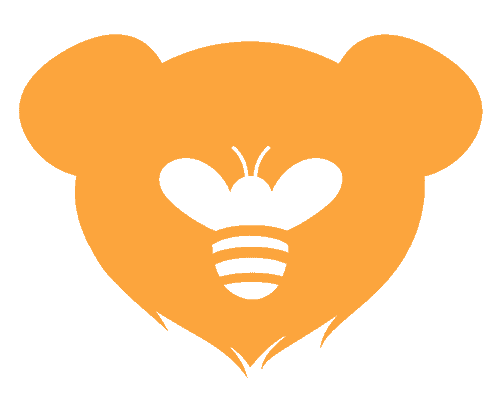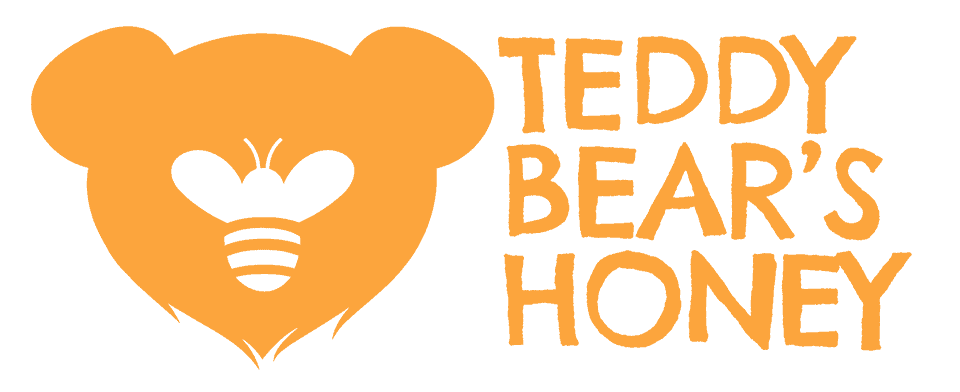Carpenter bees are sometimes called black bees. They are giant, buzzy bees that are mostly black but can have yellow or white hairy thoraxes with shiny black abdomens. Black bees are beneficial pollinators that are worth having in your garden. Sadly, they are undervalued. Carpenter bees make nests in wood and are often senselessly persecuted as pests, although they cause superficial damage only.
There are 500 species of Carpenter species in the genus Xylocopa. They make small tunnels in soft or dead wood for laying their eggs. They have solitary or primitive social lifestyles, with several females living together without a queen. Black bees look like Bumblebees but have hairless abdomen.
Black or Carpenter bees are the most misunderstood, gentle giants of the bee world. They have a crucial role in our ecosystems. Like most pollinators, they struggle in a world where pesticides put all living creatures at risk. It is worth experiencing them buzzing around your garden and neighborhood.
How To Identify Black Bees (Carpenter Bees)
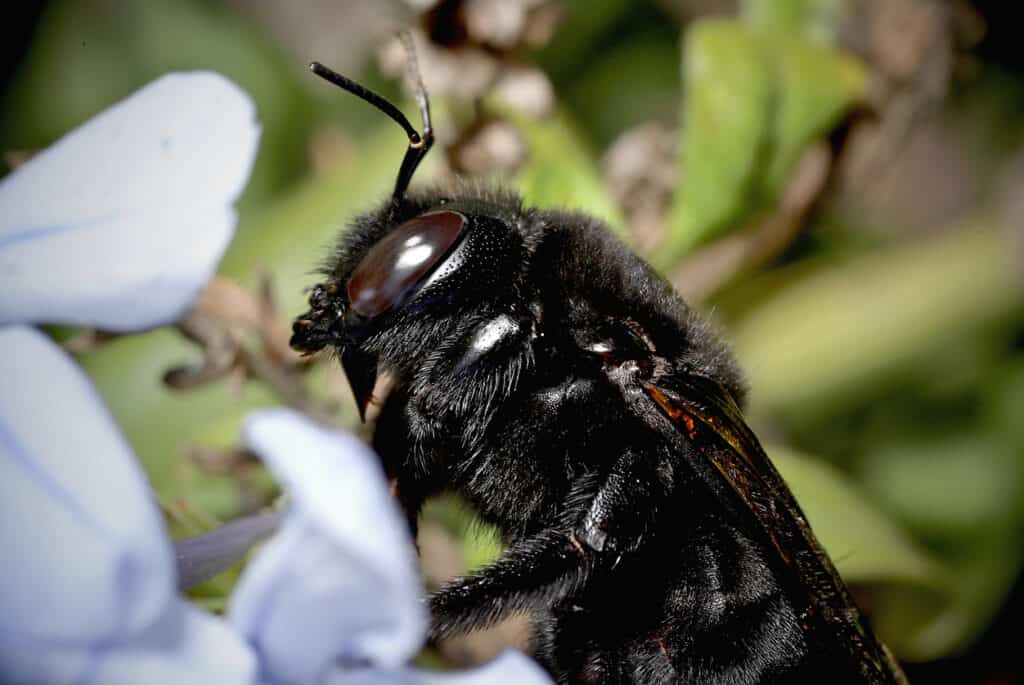
Carpenter bees live worldwide in diverse ecosystems ranging from tropical to temperate zones, except Antarctica. Carpenter bees belong to the family Apidae, the honey bee family. They were previously placed under the families Anthophoridae and Xylocopidae but have been moved to the Apidae family. Carpenter bees are categorized according to body size.
One of the false beliefs about Carpenter bees is that they eat wood. This is untrue. They only excavate a small tunnel and partition it into cells with an egg inside each chamber. They use pollen and nectar as food and can be seen visiting flowers with pollen stuck to their bodies.
Large Carpenter Bee Species (Xylocopa)
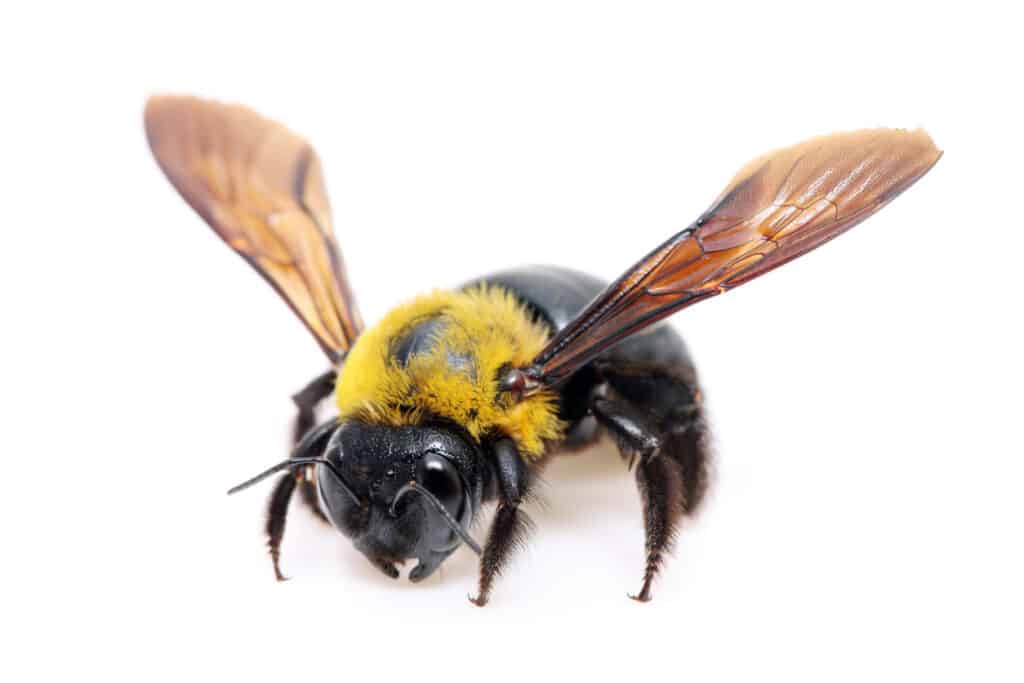
Large-sized Carpenter bees belong to the genus Xylocopa with nine native species in the USA. Xylocopa is the Greek word for ‘woodworker’ and refers to their making nests in wood. They prefer decaying or softwood like bamboo, unpainted pine, cedar, or redwood. Their tunnels are small and run along the grain, generally causing minimal damage. They reuse old tunnels where they can to save energy.
Large Carpenter bees are between 3/4 to 1 inch long. Well-known species are the Eastern Carpenter bee (Xylocopa virginica) and the Southern Carpenter bee (Xylocopa micans). Their coloration varies from black to metallic-blue, green, or purple-black. They often have yellow hair on their thorax, abdomen, or legs. Most carpenter bees have plain black bellies with yellow or white fur on their breasts.
The Central Valley Carpenter bee (Xylocopa tabaniformis orpifex) is over an inch long, with black females and golden males. These male bees are called ‘teddy bears’ because of their fuzzy, hefty yellow bodies. There are metallic blue Carpenter bees native to India and Southeast Asia. A beautiful Carpenter bee living in Thailand has wings in green, blue, and purple hues.
They are often confused with Bumblebees, which also have large black bodies. Bumblebees are much hairier, especially on their abdomens. Distinguishing the different Xylocopa species can be tricky, and characteristics like the distance between the eyes, the venation of the wings, and the number of segments in the antennae are used.
Small Carpenter Bee Species (Ceratina)
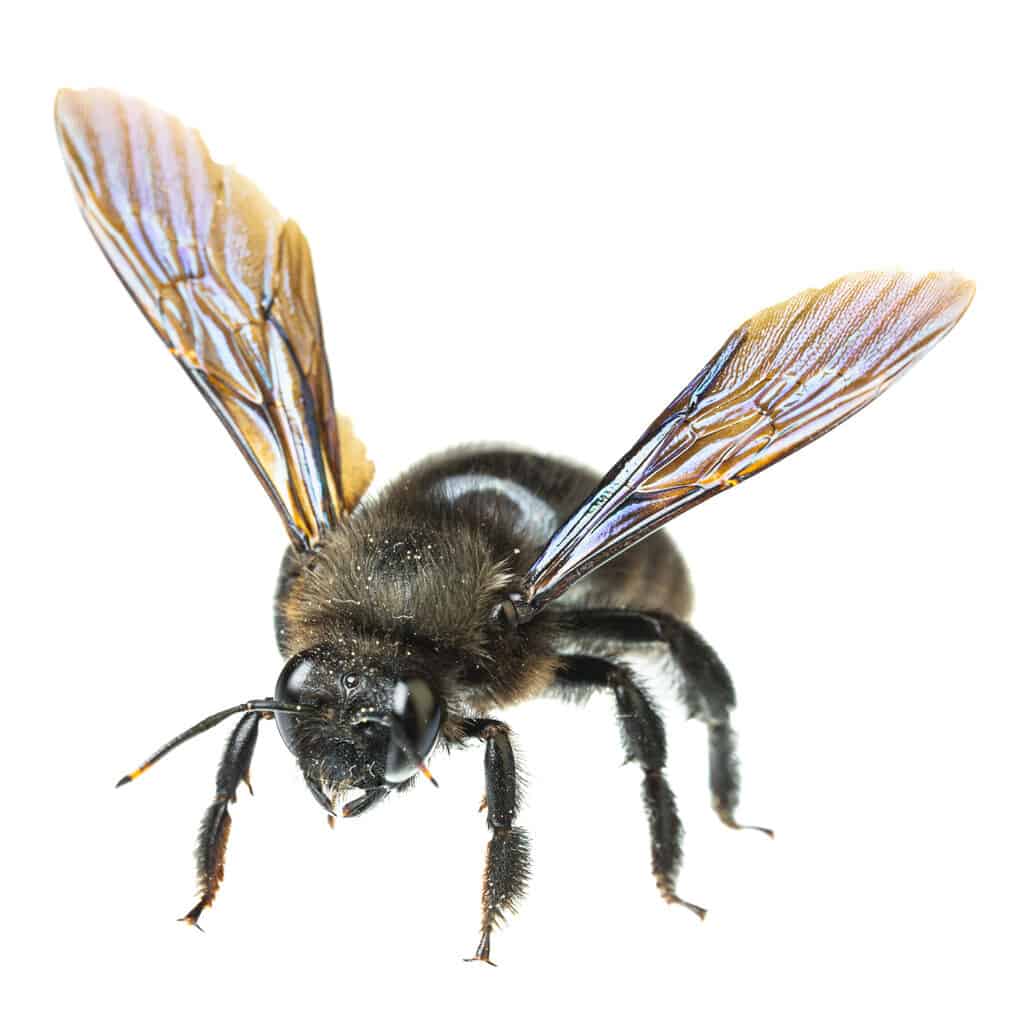
There are 350 types of small Carpenter bees worldwide belonging to the genus Ceratina; 20 of them are native to the USA. These armored bees are smaller than 3/8 of an inch (<1 cm) in length. They are black with metallic blue and green tinges and sometimes bear white or yellow markings on faces, legs, or thoraxes. Ceratina bees are primarily solitary, with one female making a nest in hollow plant stems.
Small Carpenter bees sometimes have a primitive social structure with more than one female bee in a nest. Like their bigger cousins, these small bees are excellent pollinators visiting many flowers of various fruit and vegetable species. They have long tongues and are specialists in pollinating specific tubular flowers. Some small Carpenter bees are called mining bees and dig nesting tunnels in the soil.
Some species of Ceratina bees can reproduce asexually without male bees involved.
Male And Female Carpenter Bees: Similarities And Differences
Male and female Carpenter bees are the same size with black abdomens and white or yellow markings on their breast segments. Both are active pollinators with short tongues, preferring flowers with open structures. The males differ from the females in the following ways.
- Male Carpenter bees generally have white markings on their faces, while the females have plain black faces.
- Males have larger eyes than females.
- Males have no stinger, whereas females can sting. Both are gentle creatures that will only attack when threatened.
- Males will dive-bomb intruders at the nesting site.
- Males do not burrow in wood for nest making.
- Males and females sometimes have different markings and body colors, depending on the species.
Carpenter Bees Versus Bumblebees
Carpenter bees and Bumblebees look similar and have some of the same foraging habits. Both are buzz pollinators that enhance food plants’ flowering and fruiting capabilities. This works a bit like a tuning fork or electric toothbrush. The vibrating frequencies produced by the wing muscles are transferred to the plant, releasing the pollen. Some plants like berries rely on buzz pollination.
The Carpenter bee has a shorter tongue than Bumblebees. Carpenter bees prefer to collect nectar from open flowers like daisies. They sometimes ‘steal’ nectar by biting through the side of a flower to get to the unreachable pollen and sweet treats. When this happens, the flowers might not get pollinated. Below is a chart summarizing the differences and similarities between Bumblebees and Carpenter bees.
| Bumblebees | Carpenter bees | |
| Honey making | Bumblebees make bee bread but not honey. They use honey pots inside the nest for small amounts of nectar and pollen. | Carpenter bees make bee bread but not honey. They use pollen as larval food in separate cells inside a wooden tunnel. |
| Appearance | Body: Large, hairy, rounded bodies half to 1 inch long, black with yellow or orange bands on the thorax and abdomen.Head: Densely hairy.Abdomen: Densely hairy.Wings: Rounded and translucentTongues: Long | Body: Large, rounded body 3/8 to over 1 inch long. Hairy thorax and legs. Black, sometimes with yellow or white hair on the thorax, metallic blue and green. Male carpenter bees have white spots on their heads.Head: Sparsely hairy.Abdomen: Hairless and shiny black.Wings: Triangular and metallic blackTongues: Short |
| Nesting sites | Cavity nesting mostly underground, sometimes in hollow logs and bird nests. | Nests are tunnels dug into dead wood or plant stems. |
| Colony size | 50 – 500 bees. | Solitary female or a group of 3 to 5 female bees. |
| Mating behavior | The queen leaves her nest and mates with outsider males, but only with one of them. | There is no queen. Females are attracted to male bees occupying a ‘mating site.’ |
| Communication | Communicating through body language and pheromones. | Communication through body language and pheromones. |
| Aggressiveness | Not aggressive but will defend their nest. Bumblebees can sting more than once and do not die after stinging. Only females have stings. | Not aggressive but will defend their nest. Males dive-bomb intruders. Only females have stings that they can use multiple times. |
| Pollination techniques | Bumblebees are valuable pollinators. Buzz pollination is achieved through vibrating the wing muscles, and big hairy bodies trap large quantities of pollen. Pollen is stored in corbiculae on the hind legs. | Carpenter bees are valuable pollinators. Pollen is stored in corbiculae on the hind legs. Buzz pollination is achieved through vibrating the wing muscles, and big hairy bodies trap large quantities of pollen. |
| Longevity | The Bumblebee queen survives for a year and lives through winter. Other bees and the whole colony survive less than a year. | Carpenter bees live for 1 to 3 years. |
The Lifecycle Of Black Bees (Carpenter Bees)
Carpenter bees are generally considered solitary, with only one female making a nest and rearing the young. They sometimes display semi-social and eusocial behavior with several females (mothers and daughters) living together and sharing the labors of guarding the nest, laying eggs, and foraging.
The Lifecycle Of Xylocopa Carpenter Bees
The female Xylocopa caffra bee will start making her nest in early summer. She drills a hole into softwood or chooses an existing hole in wood that she cleans up. She repeatedly brushes against the entrance as she works, leaving her unique scent there. This is how the bees find their nest easily in windy and low-light conditions.
The female Carpenter bee makes partitioned cells inside the tunnel. She licks the inside of each cell, which provides a lining that protects the cell from desiccation and humidity. She puts bee bread (a mix of pollen, nectar, and glandular secretions) in the bottom of each cell and lays one egg on top. Up to seven eggs are laid, each half an inch big. She seals each cell with sawdust and saliva.
The eggs are laid in a row, 2 or 3 days between each egg-laying event. The bottom 3 or 4 eggs will turn into females and the top eggs into males. The mother guards the nest until the new bees are about to hatch, then she dies. Eggs hatch in roughly 14 days. The larvae feed on the bee bread in the cell and mature in 3 to 4 weeks.
The mature larvae now enter a prepupal stage and do not eat for 15 days. The pupal stage lasts 36 to 40 days. The first bee emerges in mid-summer and has to bite through all the cell partitions to exit the breeding tunnel. The other bees appear at intervals of 2 or 3 days until they are all clustered at the entrance. They remain motionless for a few days, then clean the nest of sawdust and fecal pellets.
The young bees stay in the nest, foraging outside for 15 – 20 minutes per day.
The Mating Behavior Of Xylocopa Carpenter Bees
By the end of summer, when the young adult bees are 10 months old, the female bees chase the males out of the nest. The female bees become increasingly aggressive until one female becomes dominant and claims the nest as her own. The other females then leave to make new nests.
The male Carpenter bees find a safe place and stay together. In sunny weather, they choose a flowering plant to patrol and use as a place to lure the females. Mating happens in the air, close to the flowering plant. The mated females start the breeding cycle soon afterward. Depending on weather conditions, Xylocopa bees can produce one or two generations of new bees per year.
Various Carpenter bee species like Xylocopa varipuncta have a lek mating system. Males choose a landmark flowering bush or hilltop, which they defend as their territory. They wait here for female bees to arrive and mate with several different females. Sometimes several males will use the same area or flowering plant. Each male has their own portion of the plant to defend.
As soon as a male sees an interested female, he will mark a branch with his flower-scented sex pheromones. The female lands on this spot and a short mating event happen. The female Carpenter bee flies away, and the Carpenter male waits around for other females to approach.
Do Carpenter Bees Make Honey?
All bees belong to the insect order Hymenoptera containing seven families. Only some bees in the Apidae family make honey. Honey bees live together in hives, with hundreds of bees sharing the nectar gathering and honey-making labors. Carpenter bees do not make honey, as they are generally solitary bees that live with a maximum of 6 other bees.
Do Carpenter Bees Cause Damage To Wood
Carpenter bees drill holes in the wood they make a nesting chamber in. They drill small holes (¼ to ½ inches big) and create a tunnel measuring roughly 6 inches along the wood grain. They generally choose soft decaying wood-like dead tree branches, bamboo, or reeds. They will also use untreated softwood structures of pine, cedar, or redwood.
Carpenter bees do not eat wood. They will cause some sawdust to fall from the nest, but only at the start of the nesting season. This sawdust is most beneficial as a plant mulch. Sometimes woodpeckers cause damage to wood trying to get to Carpenter larvae. The damage caused by Carpenter bees is superficial and a mere annoyance compared to the advantages they have as vital pollinators.
In an era of great ecological disaster and loss of biodiversity, it is vitally important to say “No to pesticides” that harm the environment and your family’s health. Carpenter bees do not cause structural damage to wood, and there are many ways to deter them from nesting where you don’t want them. Poison manufacturers sometimes promote products by calling them safe, even if they aren’t.
How To Lure Carpenter Bees To New Nesting Sites
Plant pollinators need our protection. Consider some of the following strategies to lure Carpenter bees away from your house.
- Install a Bee-hotel you made yourself or bought online in a sheltered area of your garden. A bundle of reeds or bamboo in an area protected from rain is another option.
- Liquid bee bait can lure bees to alternative nesting places away from your house.
- Accept and enjoy the bees and allow them to live close to you. It is very entertaining to watch these buzzy creatures dancing among the flowers. Teaching children to live in harmony with nature instead of killing our fellow creatures is vitally important.
- Some people find that hanging a brown paper bag close to wooden beams you want to deter the bees from using is an effective strategy. The bees might see these as possible wasp nests.
- Bees dislike citrus and almond oils. Sprays made from non-toxic citrus oils can be sprayed on wood to deter the bees. Drops of undiluted almond oil can be used at the nest entrance.
- Garlic in powdered or minced form is intensely disliked by bees.
- Use hardwood species for the structural elements around your house and porch. Leaving some sacrificial wood untreated close to the border of your property.
- Painting wood with a shiny, smooth finish will deter carpenter bees. Staining wood is also a deterrent but is less effective.
- Pressure-treating wood makes it harder and less likely to be used by Carpenter bees.
- Leave dead trees standing as this make excellent habitats for bees and many other creatures.
- Once you are sure that the bees have moved to another nesting site, fill the nesting holes and paint the wood.
- Do not use bee traps, as these will kill the bees.
Why Carpenter Bees Are Important
Pollinating insects contribute billions of dollars to the agricultural industry. A third of our daily food comes from plants that need to be pollinated to survive. Carpenter bees are one of the pollinating insects that help 180 000 flowering plant species to enhance our lives. Crops like eggplants, berries, and tomatoes make more and larger-sized fruit when buzz-pollinated by Carpenter and Bumblebees.
The use of pesticides destroys insects and the birds and animals that eat them. Carpenter bees pollinate many wildflowers, which in turn feed birds and wildlife. They can collect pollen in windy and cold weather when smaller bees like honeybees have to stay in their hives. Birds and small mammals eat bees. These animals are essential in eradicating other insects that damage food crops.
Bee species are in decline all over our world. Their continual well-being is closely linked to our own survival. Bees are threatened because of habitat loss and the urbanization of previous grasslands. Allowing them to thrive in urban areas is the least we can do, as we now live in their former territories. It is a privilege to have Carpenter and other bees and butterflies in your suburban garden.
Are Carpenter Bees Endangered
Native bee species like the Carpenter bees are often overlooked when dwindling bee numbers are discussed. Solitary bees are in greater need of protection than honeybees farmed and cared for by honey farmers. Carpenter bees are not highly endangered, but their numbers are diminishing like most insects on our planet.
One of the significant threats to their survival is the use of Neonicotinoid poisons. These poisons are used worldwide, making every part of a plant toxic. The pollen that bees collect from these plants becomes toxins carried into bees’ nests.
Most native bee species are at risk because of deadly mites and other parasites and diseases. Invading and invasive insect species threaten the indigenous insects just as invasive alien plants threaten our indigenous flora. Providing a safe space for bees can help them overcome some of the dangers they face.
Carpenter bees are often mistakenly labeled as pests, and this misinformation is causing unnecessary extermination. Carpenter bees can cause damage to wood, but this is minor when the survival of beneficial and beautiful native bee species is at stake.
How To Help Carpenter Bees Survive
The most important way to preserve the lives of Carpenter bees is to stop the unnecessary poisoning of bees living in your neighborhood. Making people aware of the fact that they are harmless and won’t cause structural damage to houses is of vital importance.
Here are a few ways to make Carpenter and other bees in your garden happier.
- Plant indigenous trees, grasses, and flowers.
- Trees and flowers that bloom early in Spring offer a significant boost to bees after winter.
- Shallow containers with water will be visited by many bees. Place a stone in the water so that the bees can drink without drowning. This is very important in dry and hot climates.
- Leave a wild area in your garden where dry wood and deep mulch can become a bee sanctuary.
- Consider buying or making a bee hotel where bees can nest away from your house.
Interesting Facts About Carpenter Bees
Carpenter bees live in an intriguing symbiotic relationship with certain mites. Symbiosis means that two species live together, and both are better off because they do. Female Carpenter bees have a special pouch in their first abdominal segment that specific species of mites live in. This is called the acarinarium and can be seen in photographs in this article on Xylocopa ruficeps bees and their associated mites.
The mites climb onto the bee bread that the female Carpenter bee deposits in the breeding chamber to feed the eggs. Once the bee larvae turn into pupae, the mites are seen to grow in size. It seems that the mites keep the pupae clean and free of pathogens. The mites undergo their own lifecycle in the nest with the developing bees and only leave the nest in the pouches of the new bees.
Conclusion
Black bees or Carpenter bees are formidable pollinators, and they play a vital role in the habitats where they live. Even in suburbia, this is true. Their advantages far outweigh the inconvenience of a few holes in your wooden structures. Embrace the ‘teddy bears’ of the bee world as valuable inhabitants of your garden.
References
- https://www.sciencedirect.com/topics/agricultural-and-biological-sciences/carpenter-bee
- https://content.ces.ncsu.edu/carpenter-bees
- https://www.flawildflowers.org/know-your-native-pollinators-carpenter-bees/
- https://entnemdept.ufl.edu/creatures/misc/bees/xylocopa.htm
- https://keys.lucidcentral.org/keys/v3/eafrinet/bee_genera/key/african_bee_genera/Media/Html_eafrica/Ceratina_bees.htm
- https://www.bobvila.com/articles/carpenter-bee-vs-bumblebee/
- http://archive-srel.uga.edu/outreach/ecoviews/ecoview150322.htm
- https://extension.psu.edu/the-eastern-carpenter-bee-beneficial-pollinator-or-unwelcome-houseguest
- https://extension.psu.edu/planting-for-pollinators
- https://www.inaturalist.org/guide_taxa/369986
- https://www.usgs.gov/media/images/xylocopa-pop-green-fthailand-side
- https://pediaa.com/what-is-the-difference-between-male-and-female-carpenter-bees/
